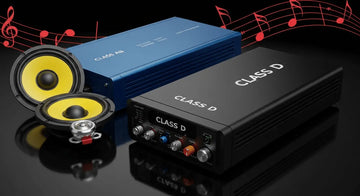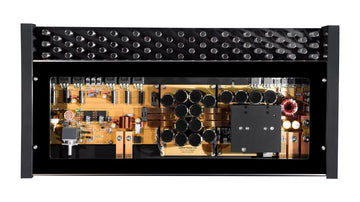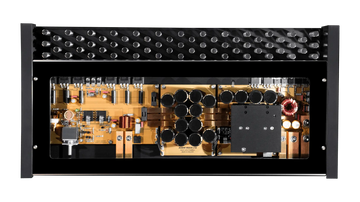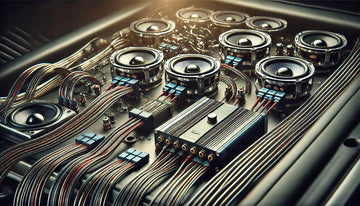Car Amplifiers are essential to any audio system, whether for home audio, car audio, or professional sound setups. Understanding car amplifier power is crucial for getting the best performance out of your speakers and achieving optimal sound quality. However, amplifier power can be a confusing topic, especially for beginners. In this beginner's guide, we will demystify amplifier power, explain the key terms you need to know, discuss the role of amplifiers in car audio, decode power ratings, explore the importance of matching amplifiers and speakers, address common misconceptions, and help you determine how much amplifier power you need. So, let's dive in and uncover the world of analog amplifier power!
Understanding Amplifier Power
To understand amplifier power, we first must grasp what amplifier power rating means. The power rating of an amplifier measures its maximum power output, including the output power, which is usually expressed in watts. This power figure is essential regarding speaker impedance matching, which we will discuss in more detail later. Understanding amplifier specifications, such as power handling, peak power, continuous power output, speaker sensitivity, impedance, and loudspeaker, is crucial for selecting the suitable amplifier for your audio setup.
The Basics of Amplifier Power
Amplifier power handling refers to the maximum power output an amplifier can sustain without distortion or damage to the amplifier itself. It's important to note that higher power handling does not necessarily mean better sound quality, as other factors like speaker sensitivity and impedance also come into play. This is why understanding amplifier power specifications is essential.
When it comes to power rating, there are two essential terms you need to know: peak power and RMS power. Peak power rating represents an amp's maximum power output in short bursts, such as peak music power output (PMPO). On the other hand, RMS power (Root Mean Square) is the continuous power output an amplifier can sustain, and it is a more realistic measure of amplifier power output. Understanding the difference between peak and RMS power is essential for selecting an amp that meets your audio needs. You would buy an 800W RMS amp and 800W Program speakers and be safe knowing your amp would have plenty of reserve power for the speakers, helping avoid clipping issues.
Decibels (dB) and sound pressure levels (SPL) are essential for power specifications. Decibels measure sound pressure level, which is the perceived loudness of sound. Total harmonic distortion (THD) is another critical factor that impacts the sound quality of amplifier power output. It refers to the level of distortion introduced by the amplifier, and lower THD values indicate cleaner sound output. The 20-watt amp is double the power of the 10-watt amp, but doubling the power only translates to an increase of 3 dB SPL.
Key Terms You Need to Know
When delving into amplifier power, it's essential to familiarize yourself with the key terms associated with power specifications. Here are some of the essential terms you need to know:
- Peak power rating: This represents the maximum power output an amplifier can handle, typically measured in watts.
- RMS power: The continuous power output an amplifier can sustain, measured in watts.
- Decibels (dB): A unit of measurement used to quantify sound pressure level, perceived loudness, or power level.
- Sound pressure level (SPL): The perceived loudness of sound, measured in decibels.
- Total harmonic distortion (THD): The level of distortion introduced by the amplifier, with lower values indicating cleaner sound output.
- Speaker impedance: The electrical resistance of a speaker, measured in ohms, which impacts the power level of amplifiers.
Understanding these key terms will help you navigate amplifier specifications and make informed decisions when selecting the suitable amplifier for your audio setup.
How powerful is a powerful amplifier?
The power of an amplifier is measured in watts. A powerful amplifier typically refers to one that can produce a high amount of wattage, usually above 100 watts per channel. However, the ideal power level for an amplifier depends on the specific audio setup and personal preferences.
Amplifier Power and Car Audio
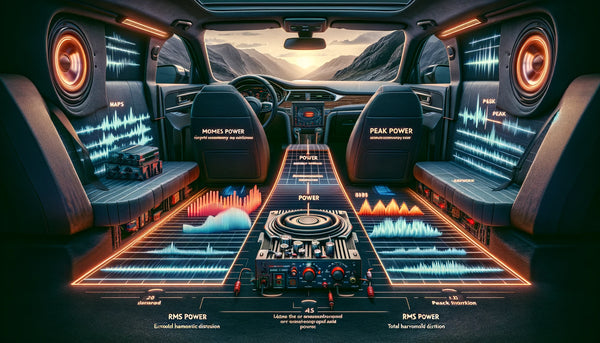
Car audio amplifiers are essential for enhancing the power of audio signals in vehicles. They drive speakers, overcome limitations, and deliver quality sound output. AC power is necessary for their operation. The design and quality of amplifier and speaker components play a crucial role in this process.
The Role of Amplifiers in Car Audio
Amplifiers are essential in car audio systems as they increase the power of audio signals, resulting in a better music experience at higher volumes. They enhance sound quality, compensate for voltage drops, and handle speaker impedance matching, ensuring consistent power output and overall audio performance.
Why Power Matters in Car Audio
Power handling is crucial for car audio, impacting loudness, sound quality, and dynamic range. It ensures distortion-free output at higher volumes. Understanding amplifier power, including dynamic power, is essential for optimal sound quality. Insufficient power can reduce quality, cause distortion, and damage speakers or amplifiers. Adequate power handling, such as dynamic power, preserves audio fidelity, especially in dynamic passages. It prevents compression and maintains detail, dynamics, and impact. Amplifiers with sufficient power handling, like dynamic power, enhance depth, clarity, and dynamic range in car audio systems.
Decoding Power Ratings

Now, let's dive deeper into power ratings and how to interpret them correctly. Understanding power specifications can be daunting, as amplifier manufacturers often use different terms and specifications to describe power output. We will explore two crucial power rating specifications, RMS power vs. peak power, and debunk the truth about 'max' power rating. It is crucial to consider the frequency range used to measure power ratings. For example, when determining the stated wattage output specification, it is essential to know if the amplifier was tested using a 1 kHz test tone or with 20 Hz to 20 kHz test tones. This information can significantly impact the accuracy and reliability of the power rating.
RMS Power vs. Peak Power
RMS power rating, as mentioned earlier, indicates the continuous power output of an amplifier. It represents the average power output an amplifier can sustain over a prolonged period without distortion or damage. RMS voltage is a more realistic measure of amplifier power output, as it accounts for continuous audio signal input.
Peak power rating, however, reflects the maximum power output an amplifier can handle, but only for short bursts of audio power, such as peak music power output (PMPO). It is important to note that peak power rating does not accurately represent continuous power output and should not be the sole factor in determining amplifier performance.
The Truth About 'Max' Power
You may often come across amplifiers boasting of their 'max' power rating, which can be misleading. Approaching the 'max' power rating cautiously is essential, as it often overstates amplifier power output capabilities. Manufacturers may use exaggerated 'max' power claims to make their amplifiers seem more powerful, but it does not accurately represent continuous power output. A 50-100 watt per channel amplifier will provide more than enough volume for most home applications. So, please don’t feel the need to buy a more powerful amplifier for the sake of it.
Focusing on RMS power rating is essential to avoid falling into the trap of misleading power specifications, as it provides a more realistic measure of amplifier power output. By understanding the real-world power output of amplifiers, you can make more informed decisions when selecting amplifiers for your audio system, ensuring that you get the power level you need.
Tips for Matching Amplifiers and Speakers
To achieve proper amplifier and speaker matching, consider the following tips:
- Consider speaker sensitivity: Speaker sensitivity, measured in decibels (dB), determines how loud the speaker will sound with a given amount of power. Matching amplifier power output with speaker sensitivity is essential to achieve desired volume levels and sound quality.
- Match power level and impedance: The power level of amplifiers should correspond with speaker impedance, typically measured in ohms. Matching amplifier power output and speaker impedance ensures maximum power output and prevents sound quality issues.
- Understand peak music power output: Peak music power output specification helps determine how much power amplification your speakers require for dynamic music passages—understanding peak music power output aids amplifier and speaker matching, ensuring optimum audio performance.
- Consider speaker impedance impact: Amplifier power output and sound quality are affected by speaker impedance values. Lower-impedance speakers require more power, while higher-impedance speakers are more power-efficient. Matching amplifier power output with speaker impedance is crucial for sound quality.
- Consider the amplifiers' conduction angle: amplifiers' conduction angle, such as class AB amplifiers, impacts speaker impedance handling. Amplifiers with appropriate conduction angles are essential for speaker impedance matching, power handling, and sound quality output.
Following these tips ensures that your amplifier and speaker are correctly matched, resulting in optimal sound quality, power handling, and audio performance.
Amplifier Power in the Real World
Let's explore amplifier power in real-world audio scenarios, focusing on sound quality and volume levels.
Power and Sound Quality
Amplifier power level plays a significant role in perceived loudness, sound quality, and total harmonic distortion of audio output. Higher amplifier power output generally results in greater perceived loudness and sound pressure level, allowing music to be played at higher volume levels without distortion.
The amplifier power level directly affects the maximum volume output of the speaker. Amplifiers with higher continuous power output can deliver higher volume levels, allowing music to be played louder without distortion.
When setting volume levels, it's essential to understand amplifier rms watts, which indicate the continuous power output of the amplifier. By selecting amplifiers with higher rms wattage, you can achieve higher volume levels without sacrificing sound quality, provided that speaker impedance and power handling specifications are also considered.
Speaker impedance, amplifier power rating, and peak power handling specifications also influence the audio output volume level. Matching amplifiers and speakers correctly ensures maximum volume level output, power handling, and sound quality, providing an enjoyable audio experience.
Misconceptions About Amplifier Power
We can prevent incorrect audio output, sound quality issues, and potential amplifier or speaker damage by debunking common myths. Here are some of the common myths about amplifier power:
- Misunderstanding amplifier peak power handling: One common audio myth is that higher peak power handling always means better sound quality. However, peak power handling is not the only factor affecting amplifiers' sound quality, loudness, and power output.
- Understanding speaker impedance, amplifier power output, and their impact on sound quality is crucial for accurate audio reproduction.
How Much Amplifier Power Do You Need?
Now, let's address how much amplifier power you need for your audio setup. The appropriate amplifier power level is crucial for achieving the desired sound quality, volume, and overall audio performance.
Frequently Asked Questions
How can I calculate the necessary amplifier power for my speakers?
Calculating the necessary amplifier power for your speakers involves considering speaker sensitivity, room size, and intended use of the speakers. Here's a formula you can use as a starting point:
Power (Watts) = (Sensitivity x Room Size)/10
To estimate the power level needed for your speakers, consider the speaker sensitivity (measured in decibels) and room size. This formula provides a rough guideline, but other factors like speaker impedance, power handling, and audio preferences should also be considered. Understanding speaker sensitivity ratings is crucial—they're measured in decibels with one watt of power at a distance of one meter from the speaker. This measurement helps determine speaker efficiency. However, you don’t need a calculator to realize that if it takes 200 watts of power to get your speakers to 85db from 3 meters away, but your chosen speakers can’t handle more than 100 watts of Continuous Power, your system simply isn’t going to work properly.
How do I correctly set up and adjust the amplifier power for optimal performance?
Once you have selected the appropriate amplifier power for your audio setup, setting up and adjusting it properly for optimal performance is essential. Follow these steps to ensure you get the best sound quality:
To optimize your amplifier and speaker setup, follow these steps:
- 1. Consult the manual: Review the manual for your amplifier and speakers to find recommended settings, power output, impedance, sensitivity, and any specific adjustments.
- 2. Adjust controls carefully: When adjusting the amplifier, use the gain and volume controls to prevent distortion or equipment damage. Gradually increase the volume while monitoring sound quality, avoiding distortion.
- 3. Ensure proper grounding and connections: Ensure the amplifier is correctly grounded and all connections are secure. Poor grounding or loose connections can introduce noise, distortion, or signal interruptions.
- 4. Fine-tune with test tones or music: Use test tones or music with a balanced frequency range to fine-tune the amplifier's power output, equalizer settings, crossover frequency, and other audio adjustments for optimal sound quality. This will help you achieve a well-balanced audio response that suits your preferences.
Conclusion
Understanding amplifier power is crucial for achieving optimal performance in your audio system. It is essential to familiarize yourself with key terms and decode power ratings to make informed decisions when matching amplifiers and speakers. While misconceptions about amplifier power exist, it's essential to debunk common myths and focus on the real-world implications of power on sound quality and volume levels.
Suppose you're looking for more in-depth information on calculating the necessary amplifier power for your speakers or adequately setting up and adjusting amplifier power. In that case, we recommend checking out our comprehensive guide on the topic. It provides step-by-step instructions and valuable insights to help you make the most out of your audio system.


